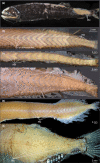Musculotendinous system of mesopelagic fishes: Stomiiformes (Teleostei)
- PMID: 34927245
- PMCID: PMC9119618
- DOI: 10.1111/joa.13614
Musculotendinous system of mesopelagic fishes: Stomiiformes (Teleostei)
Abstract
Every night the greatest migration on Earth starts in the deep pelagic oceans where organisms move up to the meso- and epipelagic to find food and return to the deeper zones during the day. One of the dominant fish taxa undertaking vertical migrations are the dragonfishes (Stomiiformes). However, the functional aspects of locomotion and the architecture of the musculotendinous system (MTS) in these fishes have never been examined. In general, the MTS is organized in segmented blocks of specific three-dimensional 'W-shaped' foldings, the myomeres, separated by thin sheets of connective tissue, the myosepta. Within a myoseptum characteristic intermuscular bones or tendons may be developed. Together with the fins, the MTS forms the functional unit for locomotion in fishes. For this study, microdissections of cleared and double stained specimens of seven stomiiform species (Astronesthes sp., Chauliodus sloani, Malacosteus australis, Eustomias simplex, Polymetme sp., Sigmops elongatus, Argyropelecus affinis) were conducted to investigate their MTS. Soft tissue was investigated non-invasively in E. schmidti using a micro-CT scan of one specimen stained with iodine. Additionally, classical histological serial sections were consulted. The investigated stomiiforms are characterized by the absence of anterior cones in the anteriormost myosepta. These cones are developed in myosepta at the level of the dorsal fin and elongate gradually in more posterior myosepta. In all but one investigated stomiiform taxon the horizontal septum is reduced. The amount of connective tissue in the myosepta is very low anteriorly, but increases gradually with body length. Red musculature overlies laterally the white musculature and exhibits strong tendons in each myomere within the muscle bundles dorsal and ventral to the horizontal midline. The amount of red musculature increases immensely towards the caudal fin. The elongated lateral tendons of the posterior body segments attach in a highly complex pattern on the caudal-fin rays, which indicates that the posterior most myosepta are equipped for a multisegmental force transmission towards the caudal fin. This unique anatomical condition might be essential for steady swimming during diel vertical migrations, when prey is rarely available.
Keywords: Argyropelecus; Astronesthes; Chauliodus; Eustomias; Malacosteus; Polymetme; Sigmops; Gonostomatidae; Phosichthyidae; Sternoptychidae; Stomiidae; caudal fin; comparative anatomy; deep-sea fishes; diel vertical migration; dragonfishes; functional morphology; intermuscular bones; locomotion; myosepta; red musculature.
© 2021 Anatomical Society.
Figures























Similar articles
-
From head to tail: the myoseptal system in basal actinopterygians.J Morphol. 2004 Feb;259(2):155-71. doi: 10.1002/jmor.10175. J Morphol. 2004. PMID: 14755748
-
The musculotendinous system of an anguilliform swimmer: Muscles, myosepta, dermis, and their interconnections in Anguilla rostrata.J Morphol. 2008 Jan;269(1):29-44. doi: 10.1002/jmor.10570. J Morphol. 2008. PMID: 17886889
-
Evolution of high-performance swimming in sharks: transformations of the musculotendinous system from subcarangiform to thunniform swimmers.J Morphol. 2006 Apr;267(4):477-93. doi: 10.1002/jmor.10412. J Morphol. 2006. PMID: 16429422
-
The fish tail as a derivation from axial musculoskeletal anatomy: an integrative analysis of functional morphology.Zoology (Jena). 2014 Feb;117(1):86-92. doi: 10.1016/j.zool.2013.10.001. Epub 2013 Oct 29. Zoology (Jena). 2014. PMID: 24290784 Review.
-
Fish swimming: patterns in muscle function.J Exp Biol. 1999 Dec;202(Pt 23):3397-403. doi: 10.1242/jeb.202.23.3397. J Exp Biol. 1999. PMID: 10562522 Review.
References
-
- Alexander, R.M. (1967) Functional design in fishes. London: Hutchinson.
-
- Alexander, R.M. (1969) The orientation of muscle fibers in the myomeres of fishes. Journal of Marine Biological Association of the UK, 49, 263–290.
-
- Altringham, J.D. & Ellerby, D.J. (1999) Fish swimming: patterns in muscle function. Journal of Experimental Biology, 202, 3397–3403. - PubMed
-
- Badcock, J. (1970) The vertical distribution of mesopelagic fishes collected on the SOND cruise. Journal of Marine Biological Association of the United Kingdom, 50, 1004–1044.
-
- Badcock, J. (1984) Gonostomatidae. In: Whitehead, P. , Bauchot, M. , Hureau, J. , Nielsen, J. & Tortonese, E. (Eds.) Fishes of the north‐eastern Atlantic and the Mediterranean, vol. I. Paris: UNESCO, pp. 284–301.
Publication types
MeSH terms
Grants and funding
LinkOut - more resources
Full Text Sources


